Multidimensional Measurement of the Level of Consistency of Farm Buildings with Rural Heritage: A Methodology Tested on an Italian Case Study
Abstract
:1. Introduction and Research Aims
1.1. Introduction and Literature Review
1.2. Aims of the Research
- to perform a numerical analysis of the formal characters of historic rural buildings with reference to their typological features;
- to analyze the relationships between the architectonic characteristics of historic rural buildings and contemporary ones and to quantify the level of discontinuity.
2. Materials and Methods
- definition of a set of parameters derived from the FarmBuiLD method for the physiognomic characterization of both historical and contemporary rural buildings (Section 2.1). The parameters described in Section 2.1 provide sets of information to be interpreted jointly [33].
- Selection of the historical and contemporary buildings samples used (Section 2.2). In fact, appropriate sampling approaches were adopted in order to select a significant and representative number of buildings to be analyzed in detail as study cases over a sub-regional territory considered for the experimental application of the developed methodology.
- Definition of an analytical procedure for the interpretation of the formal features of historic buildings and the continuity/discontinuity level of contemporary rural buildings with reference to historic ones (Section 2.3).
2.1. Set of Parameters
2.2. Sampling of Historic Rural Buildings and Contemporary Rural Buildings
2.3. Statistical Analysis Methods
3. Results and Discussion
3.1. Characterization of the Historic Study Case
3.1.1. Formal Characters of Rural Historic Buildings: Clusters
3.1.2. Formal Characteristics of the Clusters and Typologies of the Sample of Historical Rural Buildings
- stratum A has formal characters belonging to clusters 1 and 2, characterized by closed volumes, full perimeter surfaces and a perception of slender buildings in landscape (the width and length values of the building are similar to each other, and the height is equal to or more than half the value of L and W);
- stratum B has very variable formal characteristics, since the sample is distributed in all three clusters, with greater and exclusive representation in cluster 3). It is characterized by rectangular plan shapes that can be either flattened to the ground (cluster 1) or slender (cluster 2) in relation to the height, but always with a permeability-though partial-towards the landscape for EV ≠ 1 and EW ≠ 1. The following cases can be identified: buildings with ground floor walls along the entire perimeter and open loggias on the first floor (Figure 6. cluster 1-stratum B), a little portions of build whit a full-height porticos, which can be completely or partially closed, or cases where EV ≠ 1 and EW ≠ 1 are greater than 0.7 so that the buildings have a perimeter portion open at least on two (Figure 6. cluster 2-stratum B), or even fully open volumes or small portions of closed volumes, with two or more infilled perimeter sides (Figure 6. cluster 3-stratum B). Cluster 3, in particular, includes historic buildings with original function of barns: initially characterized by empty volumes and just one or two infilled perimeter walls, over time have partially closed the volumes in order to be able to serve as sheltering tools as well.
- stratum C represents mainly characters of cluster 1 and in small part of cluster 2. Thus, stratum C is predominantly characterized by shapes defined within the landscape for the height-width-length proportions of the building (Figure 6. Stratum C). While stratum A buildings are completely enclosed, stratum C, although characterized by shape compactness and the closed volumes, includes cases with empty or partial portions of the perimeter openings (EV and EW other than 1), such as the presence of full height loggias, or partial ones with loggias only on the first floor (EV = 1 and EW ≠ 1).
3.2. Relations between the Architectonic Characteristics of Historic Rural Buildings and Contemporary Ones: Continuity and/or Discontinuity
- positive for a single parameter (3/54 on the sample total), found either for δHW1 (41) or for δHL1 (9-see abacus in Figure 10), therefore dissonance with respect to cluster 1 is due to a perception of the building very slender in the landscape;
- δ positive for pairs of parameters (13/54 on the total sample): when it comes to positive δHW1 and δHL1, the buildings have closed and compact volumes but can appear either stretched upwards, with ΔHW1 and ΔHL1 positive (5), or flattened to the ground with negative ΔHW1 and ΔHL1 (No. 40-see the abacus of Figure 10 which represents a tool recess); when the dissonance is for EV1 and EW1 the δ are positive and the buildings have ΔEV1 and ΔEW1 negative i.e., they give the perception of open volumes (No. 8, 38);
- δ positive for multiple parameters (22/54 on the total sample): the building has dissonance for all formal characters both in proportions and in permeability and volume opening characters (see nr. 17 in Figure 10).
- for single parameter (3/54 on the total sample) there are dissonances as for δHW2 in residential buildings (nr. 1 see abacus in Figure 10) and for mixed functions (nr. 52).
- for pairs of parameters (16/54 on the total sample): for most cases of dissonances involving pairs of parameters (14/54 cases) these are the parameters related to the buildings form HW and HL (with δ values greater than 0.200). Given the corresponding negative values of ΔHW and ΔHL, the buildings have very flattened and elongated shapes in the landscape (e.g., nr. 26 a cellar building where both processing and storage of the wine is carried out) and with specialized production functions. For pairs of δHW2 and δBFO2 (only 2/54 cases) the buildings are stretched in the landscape (because of the HW value) and with greater openings of the perimeter surfaces, such as in case n.50 (see abacus in Figure 10) a building Intended for receptive activities and wine storage, which has a flattened form on the ground and perimeter portions with rather large openings aimed at increasing the perception of the landscape from the inside to the outside in the tasting room;
- for multiple parameters (23/54 on the total sample): a dissonance is confirmed for both the proportion and the opening and closing of the building compared to the landscape defined for cluster 1. For example, case nr. 49, a building destined for a receptive activity linked to a winery, commissioned with the aim of evoking a building of the past, has in contrast dissonance with historical characters both by proportions, since the parameters show a flattened perception of the building on the ground, and by compactness of the volume with a perimeter permeability different from the historical rural characters of the study area. Also, for cluster 2 there are positive peak values of EV and EW parameters confirming the presence of completely open and permeable buildings to the landscape.
4. Conclusions
Author Contributions
Funding
Conflicts of Interest
References
- Antrop, M. Why landscapes of the past are important for the future. Landsc. Urban Plan. 2005, 70, 21–34. [Google Scholar] [CrossRef]
- Tassinari, P.; Torreggiani, D.; Benni, S. Agriculture and development processes: Critical aspects, potential and multilevel analysis of periurban landscapes. Part II. Agric. Eng. Int. CIGR E J. 2007, IX, 1–21. [Google Scholar]
- Fuentes, J.M.; Gallego, E.; García, A.I.; Ayuga, F. New uses for old traditional farm buildings: The case of the underground wine cellars in Spain. Land Use Policy 2010, 27, 738–748. [Google Scholar] [CrossRef]
- Vos, W.; Meekes, H. Trends in European cultural landscape development: Perspectives for a sustainable future. Landsc. Urban Plan. 1999, 46, 3–14. [Google Scholar] [CrossRef]
- Montero, M.J.; López-Casares, S.; García-Moruno, L.; Hernández-Blanco, J. Visual impact on wetlands: Consequence of building sprawl in rural areas of the west of Spain. In Proceedings of the MODSIM05—International Congress on Modelling and Simulation: Advances and Applications for Management and Decision Making, Melbourne, Australia, 12–15 December 2005; pp. 3071–3077. [Google Scholar]
- Arnheim, R. The Dynamics of Architectural Form; California University Press: Berkeley, CA, USA, 1977. [Google Scholar]
- Pinto-Correia, T.; Kristensen, L. Linking research to practice: The landscape as the basis for integrating social and ecological perspectives of the rural. Landsc. Urban Plan. 2013, 120, 248–256. [Google Scholar] [CrossRef]
- La Rosa, D.; Barbarossa, L.; Privitera, R.; Martinico, F. Agriculture and the city: A method for sustainable planning of new forms of agriculture in urban contexts. Land Use Policy 2014, 41, 290–303. [Google Scholar] [CrossRef]
- Jeong, J.S.; Montero-Parejo, M.J.; García-Moruno, L.; Hernández-Blanco, J. The visual evaluation of rural areas: A methodological approach for the spatial planning and color design of scattered second homes with an example in Hervás, Western Spain. Land Use Policy 2015, 46, 330–340. [Google Scholar] [CrossRef]
- Tassinari, P.; Carfagna, E.; Benni, S.; Torreggiani, D. Wide-area spatial analysis: A first methodological contribution for the study of changes in the rural built environment. Biosyst. Eng. 2008, 100, 435–447. [Google Scholar] [CrossRef]
- Van Hoof, J.; van Dijken, F. The historical turf farms of Iceland: Architecture, building technology and the indoor environment. Build. Environ. 2008, 43, 1023–1030. [Google Scholar] [CrossRef]
- Jackson-Stepowski, S. Ensuring survival of vernacular buildings in rural towns (NSW). In Vernacular Architecture: Towards a Sustainable Future, Proceedings of the International Conference on Vernacular Heritage, Sustainability and Earthen Architecture, Valencia, Spain, 11–13 September 2014; Taylor and Francis-Balkema: Abingdon-on-Thames, UK, 2015; pp. 353–358. [Google Scholar]
- Garcia, A.I.; Ayuga, F. Reuse of abandoned buildings and the rural landscape: The situation in Spain. Trans. ASABE 2007, 50, 1383–1394. [Google Scholar] [CrossRef]
- López, F.; Lerones, P.; Llamas, J.; Gómez-García-Bermejo, J.; Zalama, E. A Review of Heritage Building Information Modeling (H-BIM). Multimodal Technol. Interact. 2018, 2, 21. [Google Scholar] [CrossRef]
- Fuentes, J.M.; López-Sánchez, M.; García, A.I.; Ayuga, F. Public abattoirs in Spain: History, construction characteristics and the possibility of their reuse. J. Cult. Herit. 2015, 16, 632–639. [Google Scholar] [CrossRef]
- Edge, H.M.; Pearson, R. Vernacular architectural form and the planning paradox: A study of actual and perceived rural building tradition. J. Archit. Plan. Res. 2001, 18, 91–109. [Google Scholar]
- Ruda, G. Rural buildings and environment. Landsc. Urban Plan. 1998, 41, 93–97. [Google Scholar] [CrossRef]
- Hernández, J.; García, L.; Ayuga, F. Assessment of the visual impact made on the landscape by new buildings: A methodology for site selection. Landsc. Urban Plan. 2004, 68, 15–28. [Google Scholar] [CrossRef]
- García-Moruno, L.; Hernández-Blanco, J.; Ayuga, F. Analysis of the exterior colour of agroindustrial buildings: A computer aided approach to landscape integration. J. Environ. Manag. 2003, 69, 93–104. [Google Scholar] [CrossRef]
- Cañas, I.; Ayuga, E.; Ayuga, F. A contribution to the assessment of scenic quality of landscapes based on preferences expressed by the public. Land Use Policy 2009, 26, 1173–1181. [Google Scholar] [CrossRef]
- García-Moruno, L.; Montero-Parejo, M.J.; Hernández-Blanco, J.; López-Casares, S. Analysis of lines and forms in buildings to rural landscape integration. Análisis Líneas y Formas las Construcciones Para la Integration en el Paisaje Rural 2010, 8, 833–847. [Google Scholar] [CrossRef]
- García-Moruno, L.; Hernández, J.; Ayuga, F. Analysis of the materials and exterior texture of agro-industrial buildings: A photo-analytical approach to landscape integration. Landsc. Urban Plan. 2006, 74, 110–124. [Google Scholar] [CrossRef]
- Hernández, J.; López-Casares, S.; Montero, M.J. Methodological analysis of the relationship between building envelope and surroundings in rural areas to improve the landscape integration. Inf. Construcción 2014, 65, 497–508. [Google Scholar] [CrossRef]
- Arriaza, M.; Cañas-Ortega, J.F.; Cañas-Madueño, J.A.; Ruiz-Aviles, P. Assessing the visual quality of rural landscapes. Landsc. Urban Plan. 2004, 69, 115–125. [Google Scholar] [CrossRef]
- Tempesta, T. People’s preferences and landscape evaluation in Italy: A review. New Medit 2014, 13, 50–59. [Google Scholar]
- Tempesta, T. The perception of agrarian historical landscapes: A study of the Veneto plain in Italy. Landsc. Urban Plan. 2010, 97, 258–272. [Google Scholar] [CrossRef]
- Kaplan, A.; Taşkın, T.; Önenç, A. Assessing the Visual Quality of Rural and Urban-fringed Landscapes surrounding Livestock Farms. Biosyst. Eng. 2006, 95, 437–448. [Google Scholar] [CrossRef]
- Deghati Najd, M.; Ismail, N.A.; Maulan, S.; Mohd Yunos, M.Y.; Dabbagh Niya, M. Visual preference dimensions of historic urban areas: The determinants for urban heritage conservation. Habitat Int. 2015, 49, 115–125. [Google Scholar] [CrossRef]
- Panagopoulos, T.; Barreira, A.P. Shrinkage perceptions and smart growth strategies for the municipalities of Portugal. Built Environ. 2012, 38, 276–292. [Google Scholar] [CrossRef]
- Tassinari, P.; Torreggiani, D.; Benni, S.; Dall’Ara, E. Landscape Quality in Farmyard Design: An Approach for Italian Wine Farms. Landsc. Res. 2013, 38, 729–749. [Google Scholar] [CrossRef]
- Torreggiani, D.; Tassinari, P. Landscape quality of farm buildings: The evolution of the design approach in Italy. J. Cult. Herit. 2012, 13, 59–68. [Google Scholar] [CrossRef]
- Tassinari, P.; Torreggiani, D.; Benni, S.; Dall’Ara, E. Research model for farm building design: General structure and physiognomic characterization phase. Agric. Eng. Int. CIGR E J. 2010, 12, 47–54. [Google Scholar]
- Tassinari, P.; Torreggiani, D.; Benni, S.; Dall’Ara, E.; Pollicino, G. The FarmBuiLD model (farm building landscape design): First definition of parametric tools. J. Cult. Herit. 2011, 12, 485–493. [Google Scholar] [CrossRef]
- Benni, S.; Torreggiani, D.; Carfagna, E.; Pollicino, G.; Dall’Ara, E.; Tassinari, P. A methodology for the analysis of dimensional features of traditional rural buildings to implement the farmbuild model. Trans. ASABE 2012, 55, 241–248. [Google Scholar] [CrossRef]
- Maino, E.; Benni, S.; Torreggiani, D.; Barbaresi, A.; Tassinari, P. A quantitative physiognomic analysis of contemporary farm buildings to improve awareness in rural planning. Trans. ASABE 2016, 59, 509–519. [Google Scholar]
- Bell, S. Elements of Visual Design in the Landscape; Taylor & Francis: Abingdon-on-Thames, UK, 1995. [Google Scholar]
- Di Fazio, S. Designing agricultural buildings in relation to the landscape. In Proceedings of the 11th International Congress on Agricultural Engineering, Dublin, Ireland, 4–8 September 1989; Dodd, V.A., Grace, P.M., Balkema, Eds.; CRC Press: Rotterdam, The Netherlands, 1989; pp. 1191–1198. [Google Scholar]
- Tassinari, P.; Carfagna, E.; Torreggiani, D.; Benni, S.; Zagoraiou, M. The study of changes in the rural built environment: Focus on calibration and improvement of an areal sampling approach. Biosyst. Eng. 2010, 105, 486–494. [Google Scholar] [CrossRef]
- Jolliffe, I.T. Principal Component Analysis. J. Am. Stat. Assoc. 2002, 98, 487. [Google Scholar]
- MacQueen, J.B. Some Methods for classification and Analysis of Multivariate Observations. In Proceedings of the 5th Berkeley Symposium on Mathematical Statistics and Probability, Berkeley, CA, USA, 21 June–18 July 1965 and 27 December 1965–7 January 1966; University of California Press: Berkeley, CA, USA, 1967; Volume 1, pp. 281–297. [Google Scholar]
- Jain, A.K.; Murty, M.N.; Flynn, P.J. Data clustering: A review. ACM Comput. Surv. 1999, 31, 264–323. [Google Scholar] [CrossRef]
- Saisana, M.; Saltelli, A.; Tarantola, S. Uncertainty and sensitivity analysis techniques as tools for the quality assessment of composite indicators. J. R. Stat. Soc. Ser. A Stat. Soc. 2005, 168, 307–323. [Google Scholar] [CrossRef]
- Nardo, M.; Saisana, M.; Saltelli, A.; Tarantola, S.; Hoffman, A.; Giovannini, E. OECD Statistics Working Paper-Handbook on constructing composite indicators: Methodology and user guide. Organ. Econ. Co-Oper. Dev. 2005, Single Volume, 162. [Google Scholar]
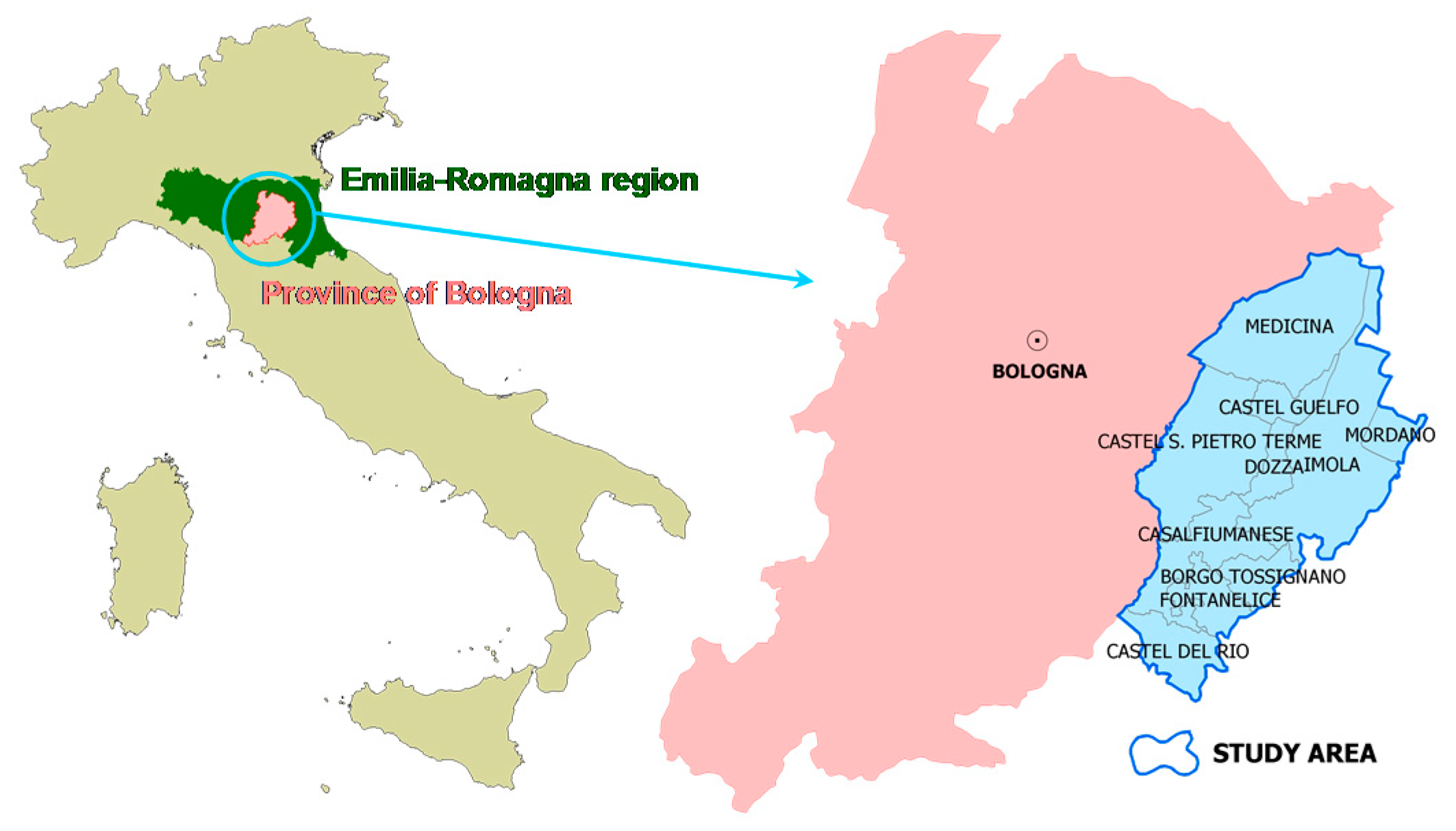
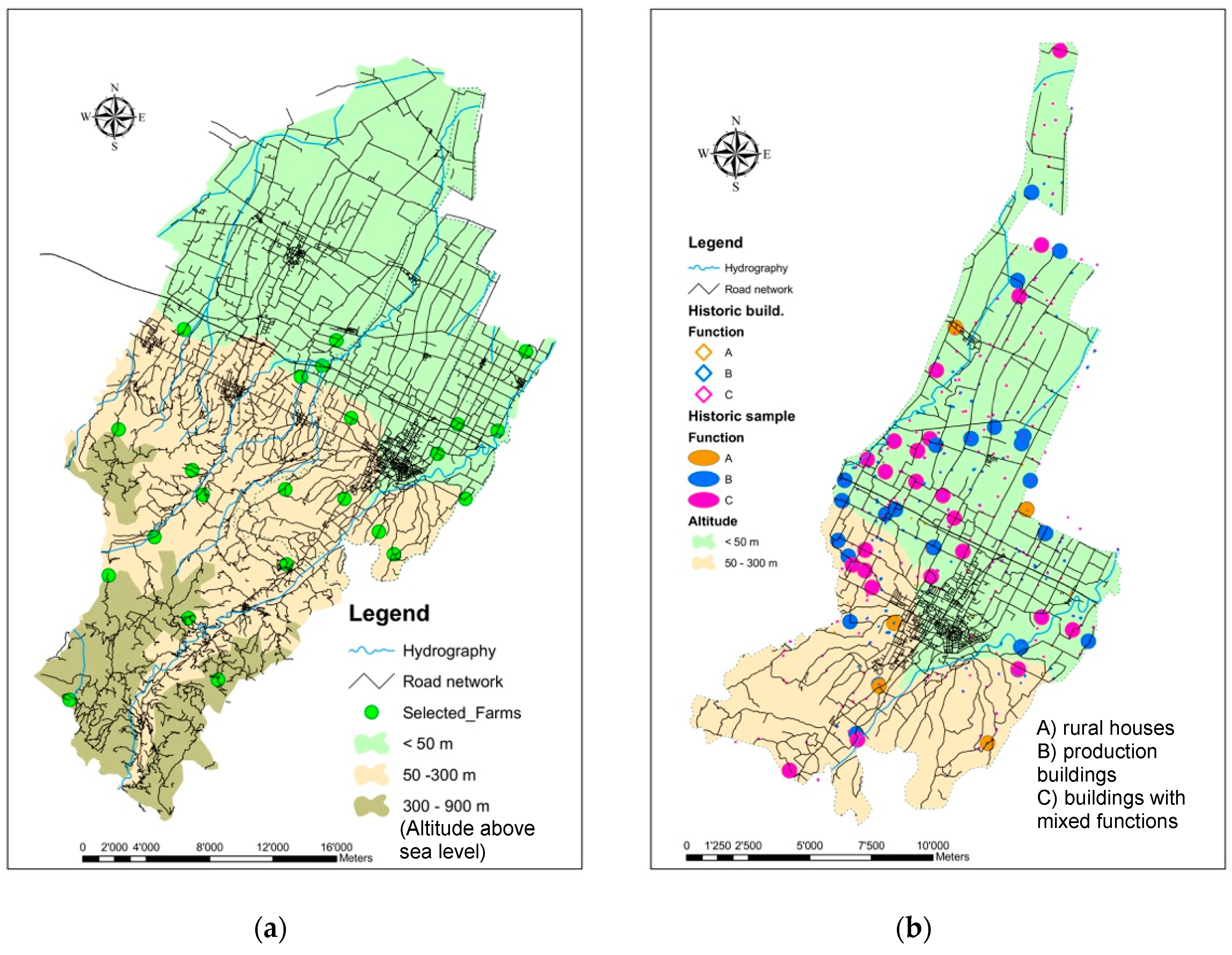
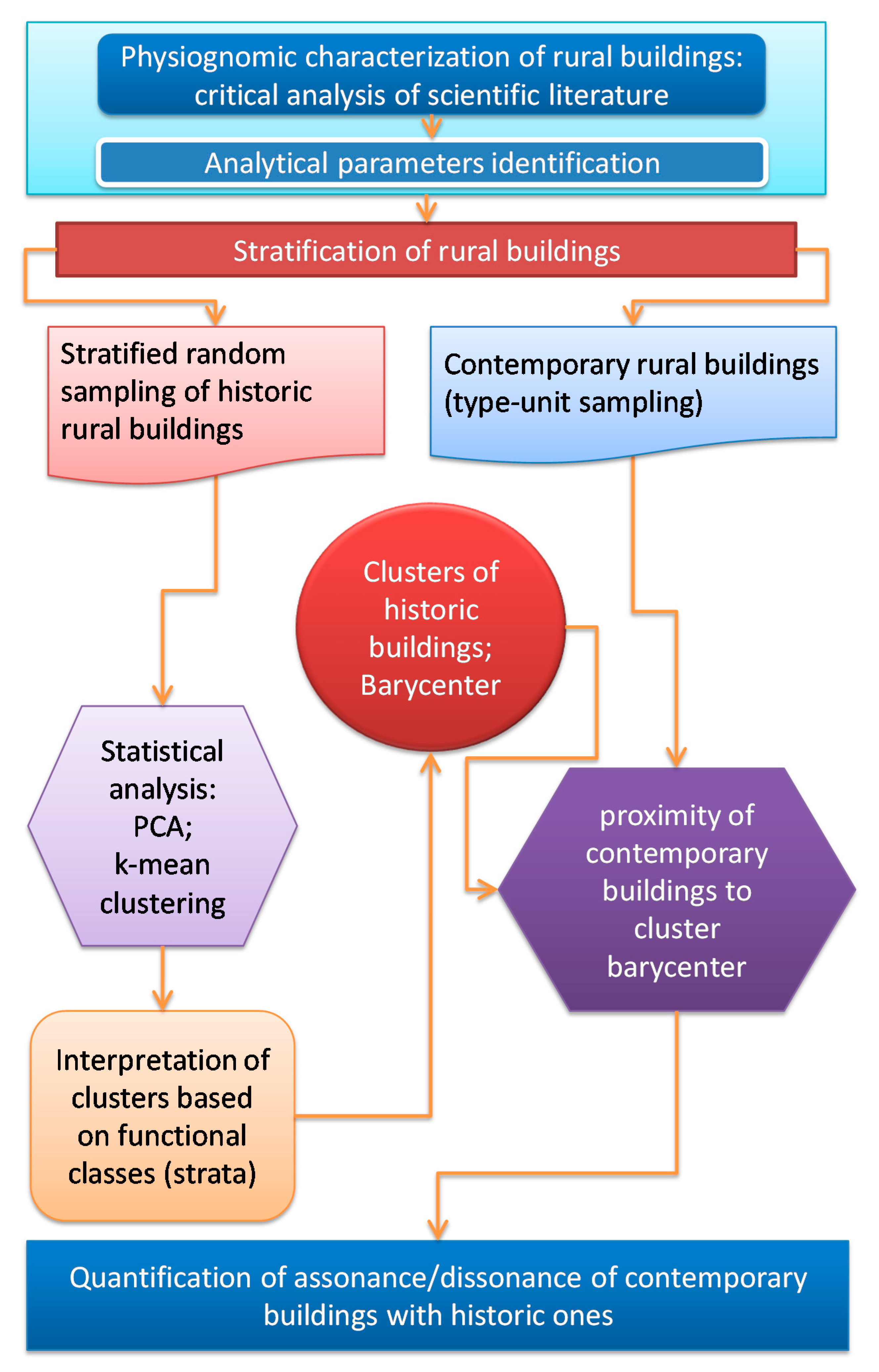
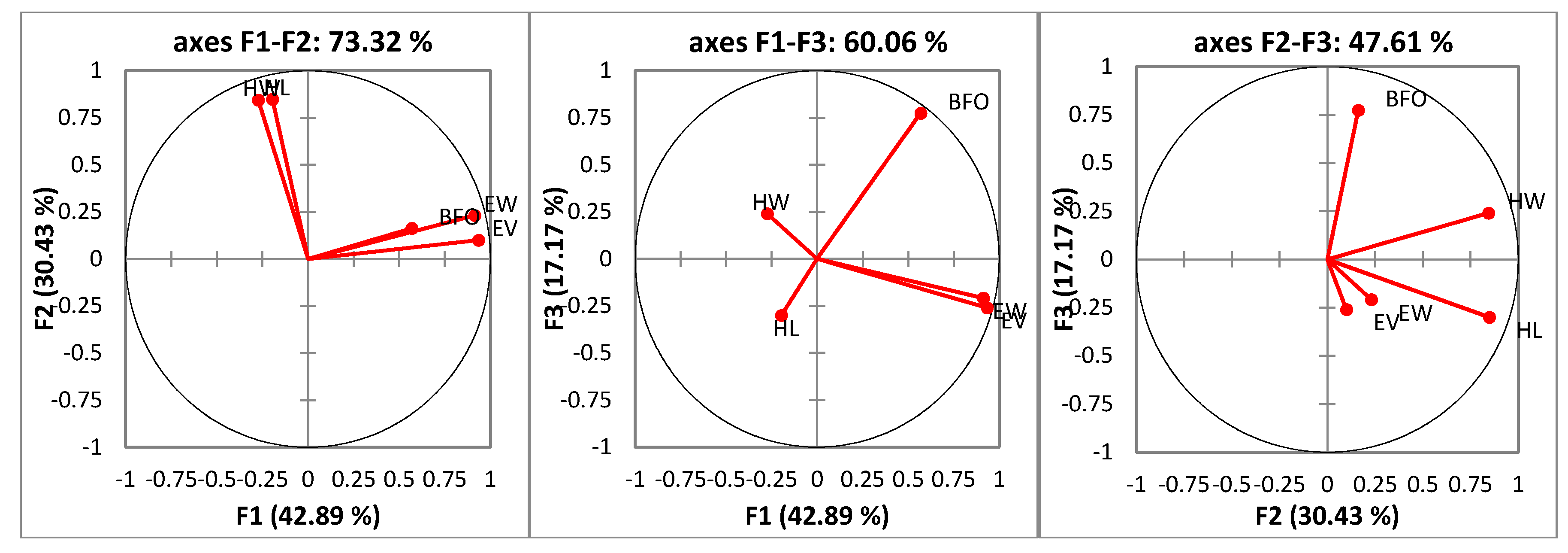
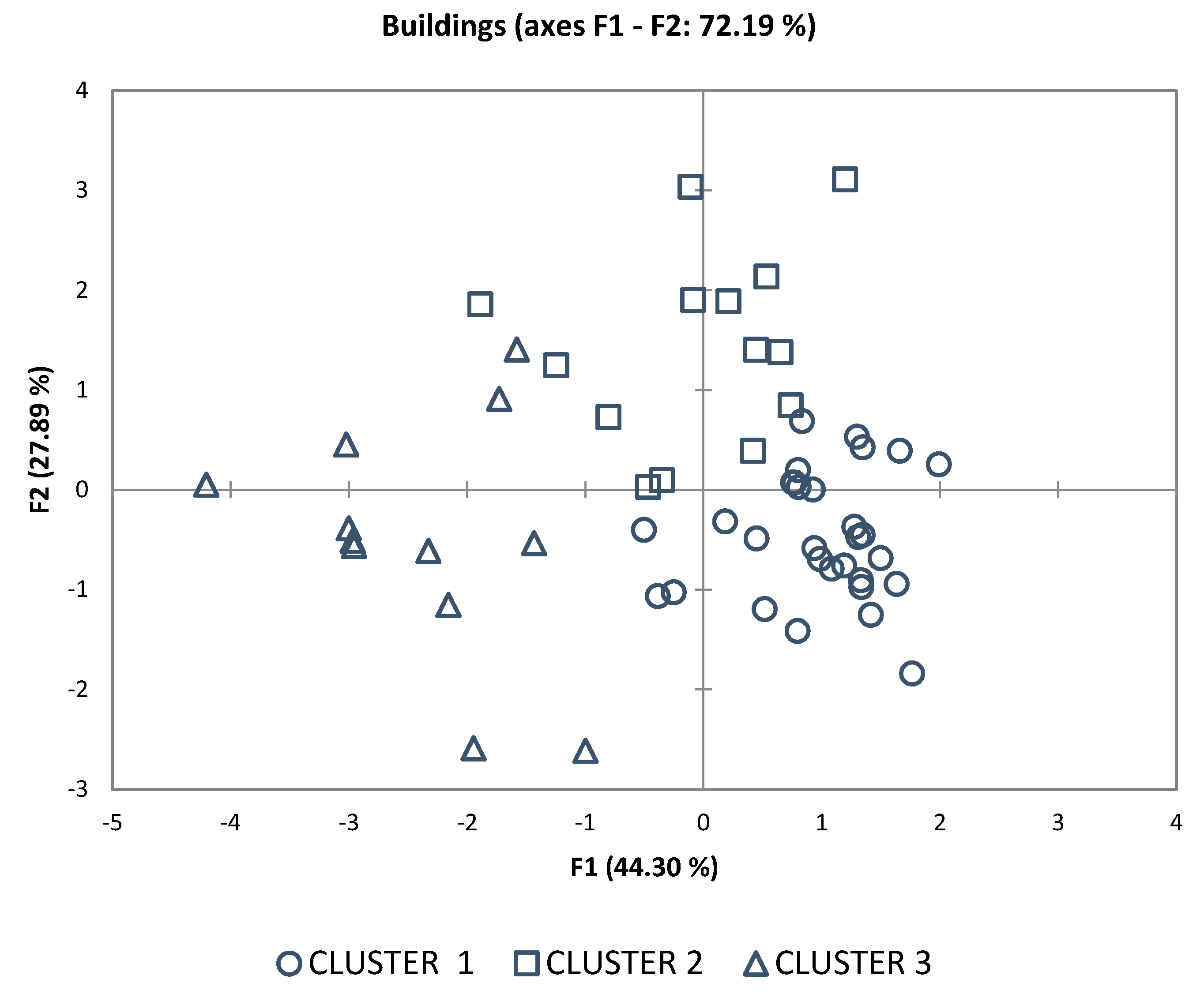
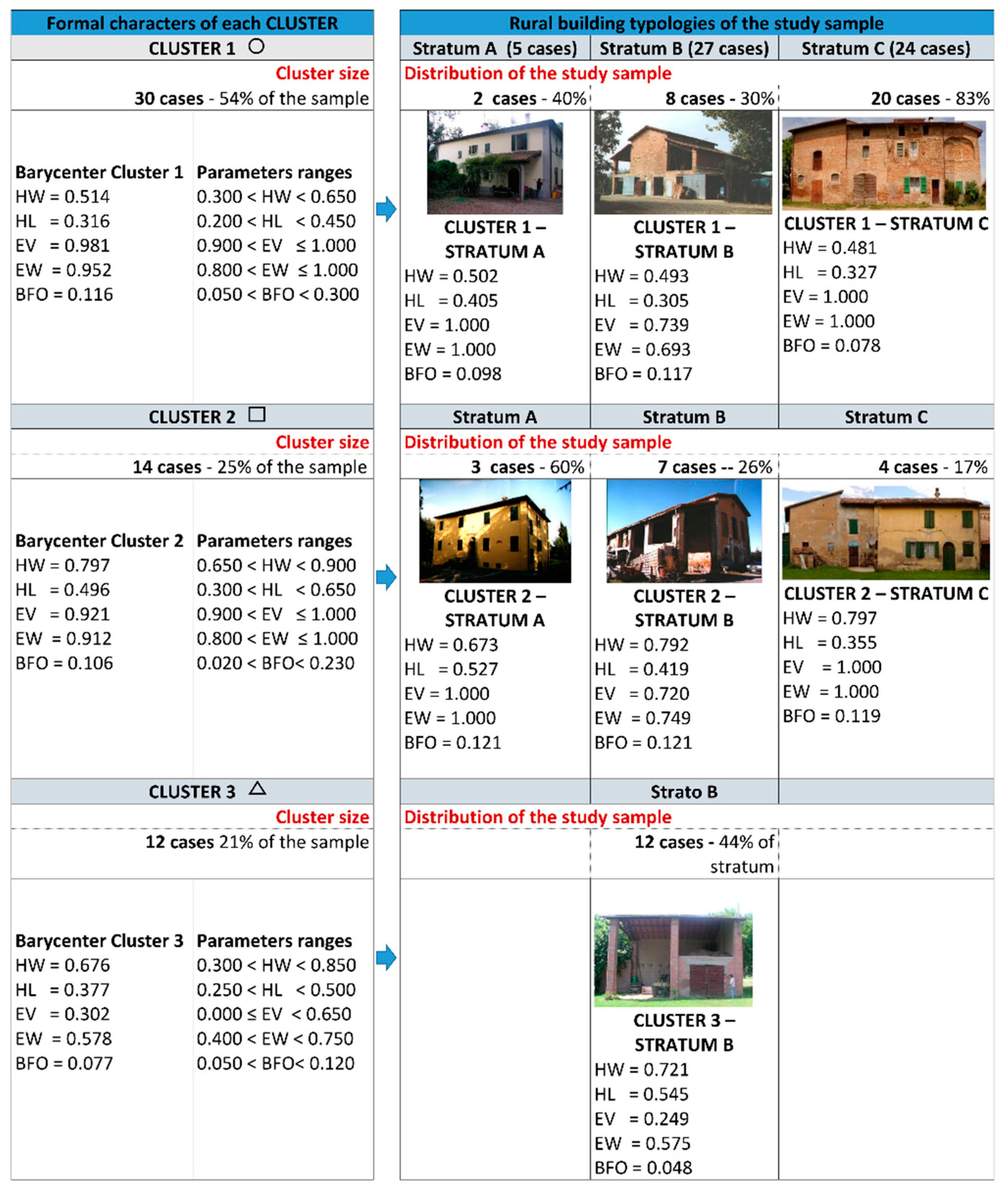

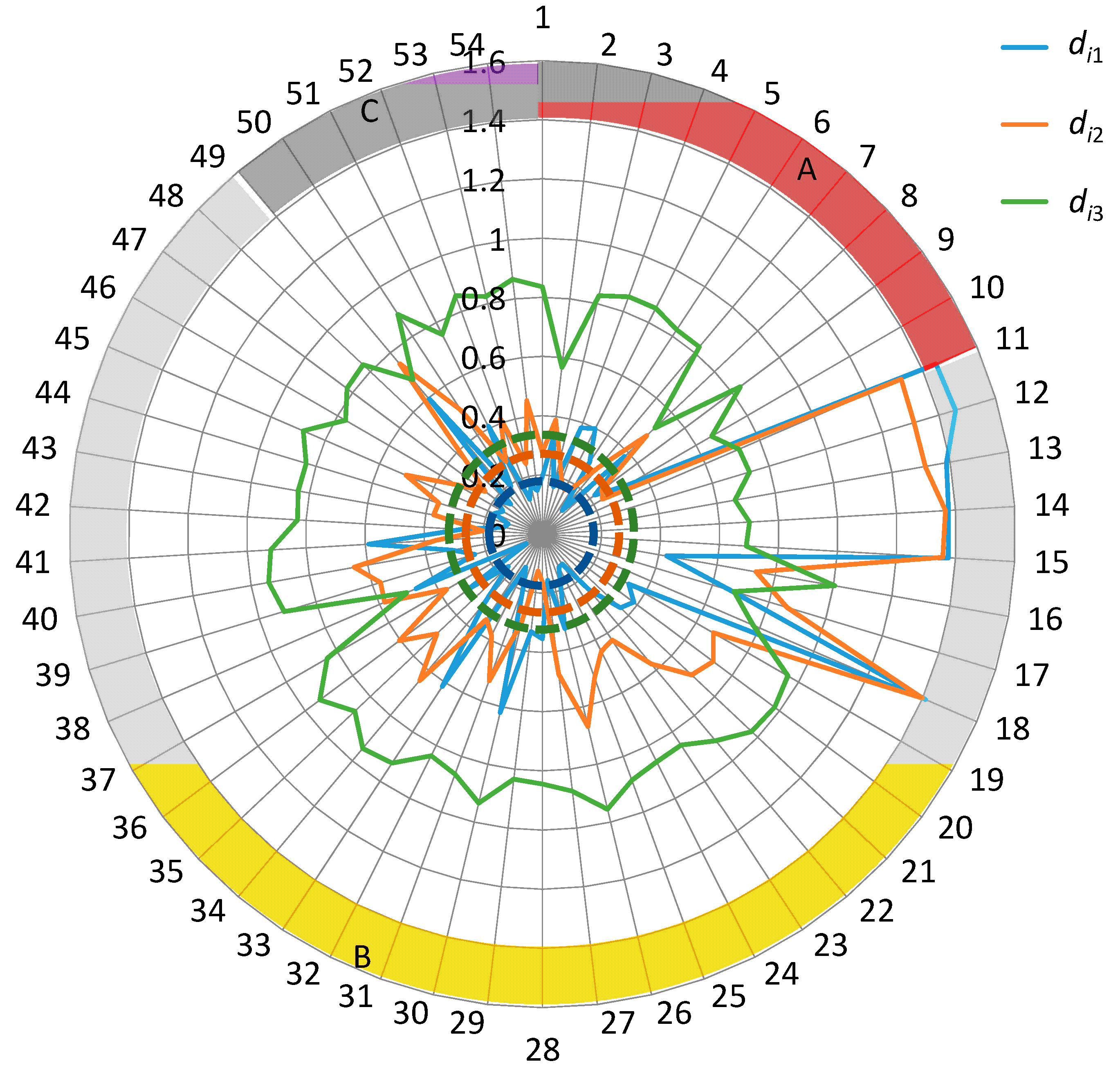
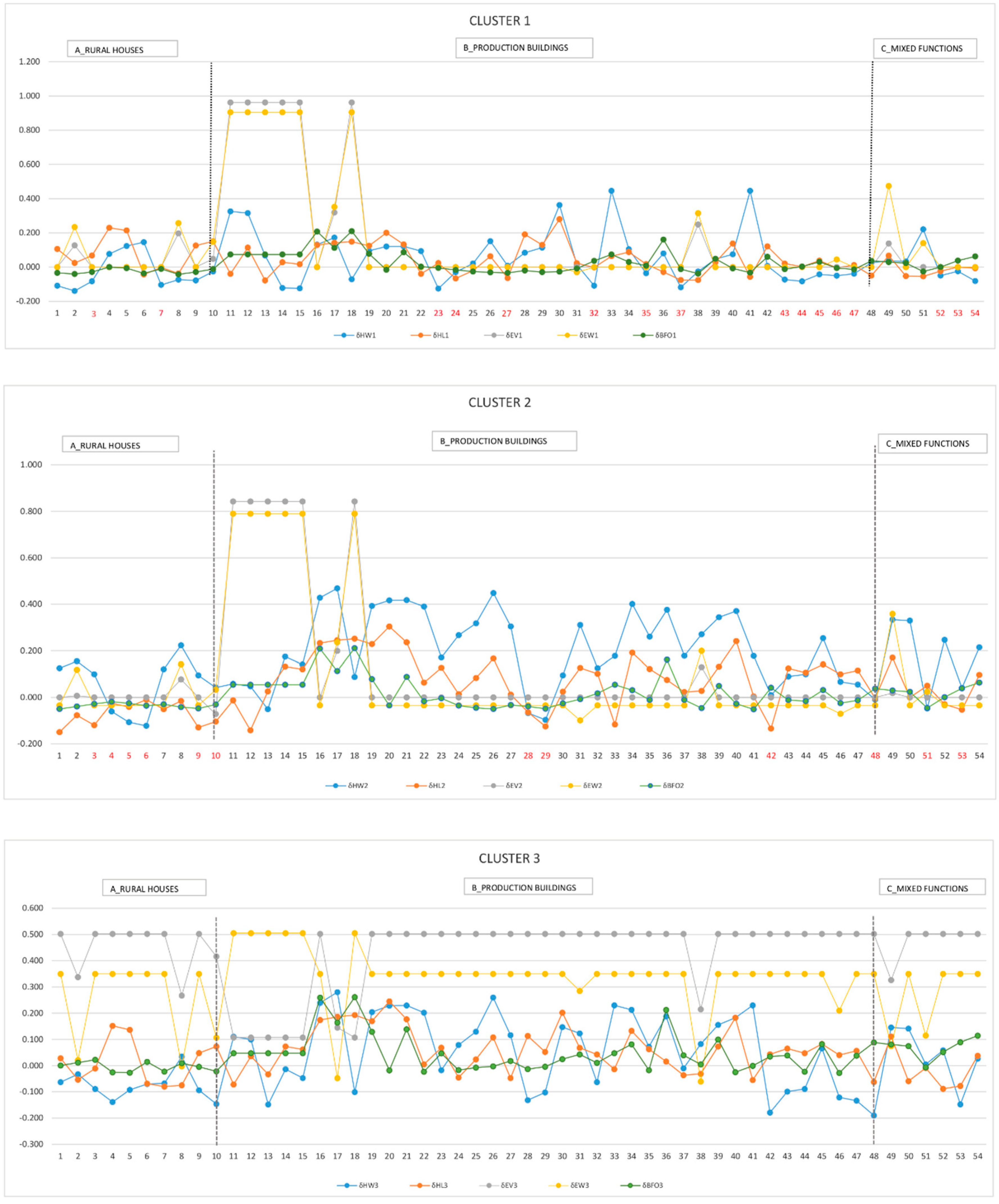
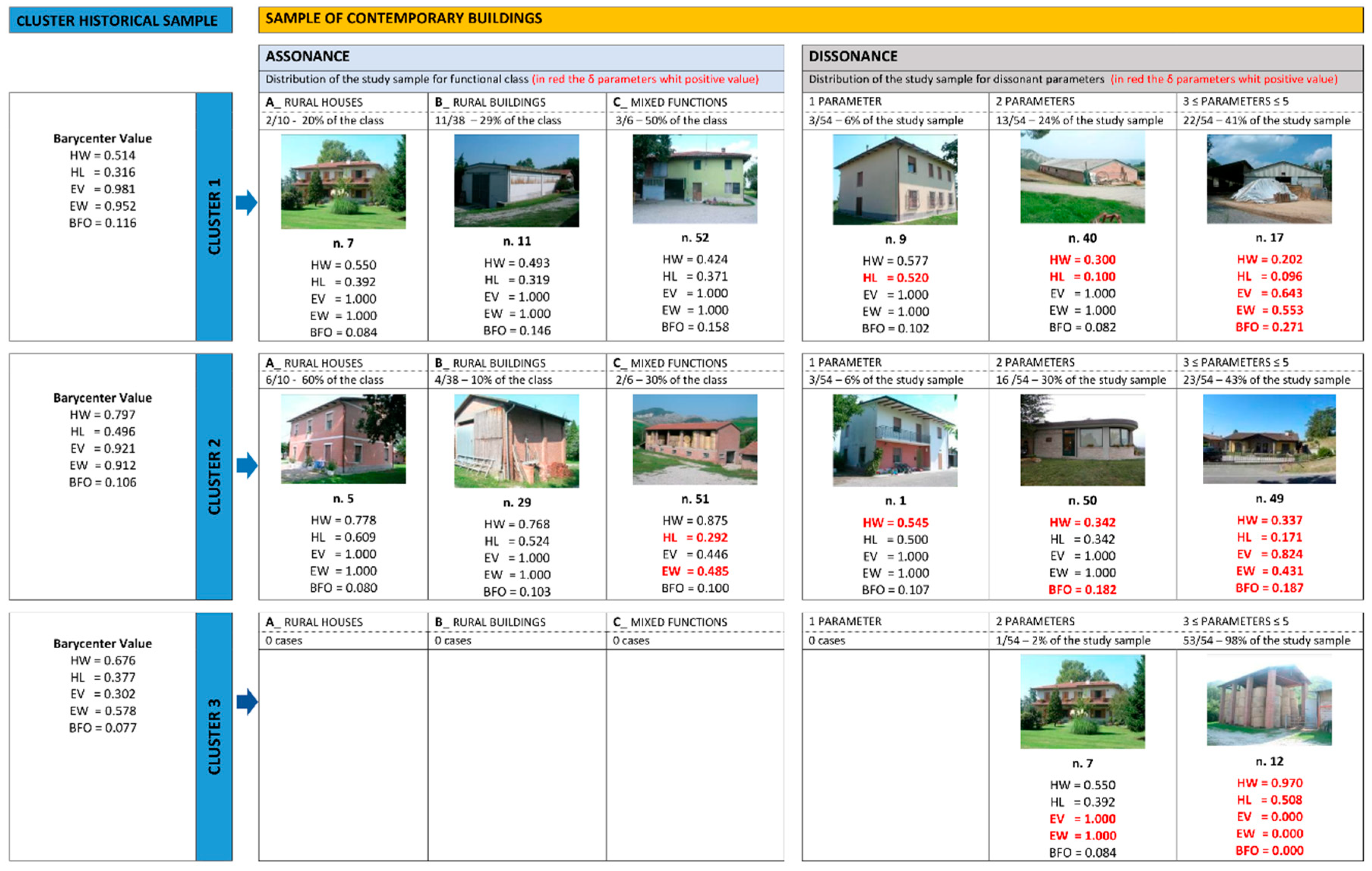
| Height to Width ratio Ratio of the height to the width (shorter side) | HW = H/W H = building height W = building width |
| Height to Length ratio Ratio of the height to the length (longer side) | HL = H/L H = building height L = building length |
| Enclosed Volumes to open ratio Ratio of the sum of the closed volumes to the overall volume | EV = E/V E = closed volumes V = open volumes |
| Enclosing walls ratio Ratio of the sum of the surfaces of the boundary fronts made up of walls to the overall surface of the boundary fronts | EW = ΣW/ΣF W = peripheral surfaces closed F = peripheral surfaces closed |
| Building front openings ratio Ratio of the total surface of openings on boundary walls (door and windows) to the surface of boundary walls | BFO = ΣO/ΣW O = open surfaces on the façades W = overall outer peripheral surface |
| Parameter | HW | HL | EV | EW | BFO |
|---|---|---|---|---|---|
| HW | 1 | 0.472 | −0.275 | −0.128 | 0.057 |
| HL | 0.472 | 1 | −0.053 | −0.038 | −0.147 |
| EV | −0.275 | −0.053 | 1 | 0.890 | 0.350 |
| EW | −0.128 | −0.038 | 0.890 | 1 | 0.377 |
| BFO | 0.057 | −0.147 | 0.350 | 0.377 | 1 |
| F1 | F2 | F3 | F4 | F5 | |
|---|---|---|---|---|---|
| Eigenvalue | 2.215 | 1.395 | 0.875 | 0.422 | 0.094 |
| Variability (%) | 44.296 | 27.894 | 17.495 | 8.445 | 1.870 |
| % cumulated | 44.296 | 72.190 | 89.685 | 98.130 | 100.000 |
| CLUSTER | HW | HL | EV | EW | BFO | Variance within Cluster | Min Distance from Centroid | Avg Distance from Centroid | Max Distance from Centroid |
|---|---|---|---|---|---|---|---|---|---|
| 1 | 0.514 | 0.316 | 0.981 | 0.952 | 0.116 | 0.031 | 0.058 | 0.157 | 0.356 |
| 2 | 0.797 | 0.496 | 0.921 | 0.912 | 0.106 | 0.074 | 0.136 | 0.250 | 0.428 |
| 3 | 0.676 | 0.377 | 0.302 | 0.578 | 0.077 | 0.100 | 0.084 | 0.270 | 0.560 |
| STRATUM | HW | HL | EV | EW | BFO |
|---|---|---|---|---|---|
| A | 0.673 | 0.527 | 1.000 | 1.000 | 0.097 |
| B | 0.662 | 0.372 | 0.720 | 0.724 | 0.070 |
| C | 0.508 | 0.310 | 1.000 | 1.000 | 0.123 |
| STR. A | STR. B | STR. C | |
|---|---|---|---|
| CLUSTER 1 | 0.270 | 0.384 | 0.053 |
| CLUSTER 2 | 0.174 | 0.333 | 0.364 |
| CLUSTER 3 | 0.830 | 0.443 | 0.837 |
| Functional Class | Assonance with Cluster | |||
|---|---|---|---|---|
| 1 | 2 | 3 | ||
| A: contemporary rural houses | 20% | 60% | - | Closed volumes and perimeter surfaces and building blocks slender upwards, with variable plan shapes. |
| B: contemporary farm buildings for production | 29% | 9% | - | Diversity in terms of shapes and relationships with the surrounding landscape due to the specific functional and performance requirements [35]; variable plan shapes, stretched in the landscape and with compact and closed volumes; peaks of distances from the centroids of clusters 1 and 2. |
| C: contemporary buildings with two or more functions | 50% | 33% | - | Full volume buildings and shapes perceived as stretched in the landscape |
| ID | ΔHWi1 | ΔHLi1 | ΔEVi1 | ΔEWi1 | ΔBFOi1 |
|---|---|---|---|---|---|
| 3 | 0.057 | 0.145 | 0.019 | 0.048 | 0.013 |
| 7 | 0.036 | 0.076 | 0.019 | 0.048 | −0.032 |
| 23 | −0.014 | −0.102 | 0.019 | 0.048 | 0.038 |
| 24 | −0.110 | 0.012 | 0.019 | 0.048 | −0.026 |
| 27 | −0.148 | 0.014 | 0.019 | 0.048 | 0.009 |
| 32 | 0.031 | −0.076 | 0.019 | 0.048 | −0.079 |
| 35 | −0.104 | −0.096 | 0.019 | 0.048 | −0.051 |
| 37 | −0.022 | 0.003 | 0.019 | 0.048 | 0.030 |
| 43 | 0.067 | −0.099 | 0.019 | 0.048 | 0.030 |
| 44 | 0.057 | −0.081 | 0.019 | 0.048 | −0.045 |
| 45 | −0.098 | −0.116 | 0.019 | 0.048 | 0.073 |
| 52 | −0.090 | 0.055 | 0.019 | 0.048 | 0.043 |
| 53 | 0.116 | 0.078 | 0.019 | 0.048 | 0.080 |
| 54 | −0.058 | −0.071 | 0.019 | 0.048 | 0.105 |
| 46 | 0.090 | −0.074 | 0.019 | −0.092 | −0.037 |
| 47 | 0.102 | −0.090 | 0.019 | 0.048 | 0.029 |
| ID | ΔHWi1 | ΔHLi1 | ΔEVi1 | ΔEWi1 | ΔBFOi1 | |
|---|---|---|---|---|---|---|
| 1 | 0.031 | 0.184 | 0.019 | 0.048 | −0.009 | DISSONANCE |
| 2 | 0.001 | 0.103 | −0.145 | −0.282 | 0.002 | |
| 4 | 0.217 | 0.308 | 0.019 | 0.048 | −0.043 | |
| 5 | 0.263 | 0.293 | 0.019 | 0.048 | −0.036 | |
| 6 | 0.286 | 0.035 | 0.019 | 0.048 | 0.005 | |
| 8 | −0.067 | 0.041 | −0.216 | −0.305 | 0.000 | |
| 9 | 0.062 | 0.204 | 0.019 | 0.048 | −0.014 | |
| 11 | 0.466 | 0.038 | −0.981 | −0.952 | −0.116 | |
| 12 | 0.455 | 0.192 | −0.981 | −0.952 | −0.116 | |
| 13 | 0.207 | 0.000 | −0.981 | −0.952 | −0.116 | |
| 14 | −0.018 | −0.107 | −0.981 | −0.952 | −0.116 | |
| 15 | 0.016 | −0.095 | −0.981 | −0.952 | −0.116 | |
| 16 | −0.271 | −0.207 | 0.019 | 0.048 | 0.250 | |
| 17 | −0.312 | −0.220 | −0.338 | −0.399 | 0.155 | |
| 18 | 0.069 | −0.226 | −0.981 | −0.952 | 0.252 | |
| 19 | −0.236 | −0.203 | 0.019 | 0.048 | 0.120 | |
| 20 | −0.260 | −0.279 | 0.019 | 0.048 | −0.027 | |
| 21 | −0.261 | −0.211 | 0.019 | 0.048 | 0.129 | |
| 22 | −0.234 | −0.038 | 0.019 | 0.048 | −0.045 | |
| 25 | −0.161 | −0.058 | 0.019 | 0.048 | −0.017 | |
| 26 | −0.292 | −0.141 | 0.019 | 0.048 | −0.012 | |
| 28 | 0.224 | 0.269 | 0.019 | 0.048 | −0.022 | |
| 29 | 0.253 | 0.208 | 0.019 | 0.048 | −0.013 | |
| 30 | 0.503 | 0.358 | 0.019 | 0.048 | 0.016 | |
| 31 | −0.154 | −0.101 | 0.019 | −0.017 | 0.034 | |
| 33 | 0.586 | 0.142 | 0.019 | 0.048 | −0.116 | |
| 34 | −0.244 | −0.166 | 0.019 | 0.048 | 0.072 | |
| 36 | −0.220 | −0.049 | 0.019 | 0.048 | 0.203 | |
| 38 | −0.114 | −0.002 | −0.268 | −0.363 | −0.004 | |
| 39 | −0.187 | −0.107 | 0.019 | 0.048 | 0.091 | |
| 40 | −0.214 | −0.216 | 0.019 | 0.048 | −0.034 | |
| 41 | 0.586 | 0.021 | 0.019 | 0.048 | −0.010 | |
| 42 | 0.147 | 0.199 | 0.019 | 0.048 | −0.103 | |
| 49 | −0.177 | −0.145 | −0.157 | −0.522 | 0.071 | |
| 50 | −0.173 | 0.025 | 0.019 | 0.048 | 0.066 | |
| 51 | 0.361 | −0.024 | 0.019 | −0.187 | −0.016 | |
| 48 | 0.166 | 0.029 | 0.019 | 0.048 | 0.079 | |
| 10 | 0.115 | 0.229 | −0.067 | −0.195 | −0.031 |
| ID | ΔHWi2 | ΔHLi2 | ΔEVi2 | ΔEWi2 | ΔBFOi2 | |
|---|---|---|---|---|---|---|
| 3 | −0.225 | −0.034 | 0.079 | 0.088 | 0.023 | ASSONANCE |
| 4 | −0.065 | 0.128 | 0.079 | 0.088 | −0.033 | |
| 5 | −0.019 | 0.113 | 0.079 | 0.088 | −0.026 | |
| 6 | 0.003 | −0.144 | 0.079 | 0.088 | 0.015 | |
| 9 | −0.220 | 0.025 | 0.079 | 0.088 | −0.004 | |
| 10 | −0.168 | 0.049 | −0.007 | −0.155 | −0.021 | |
| 28 | −0.058 | 0.090 | 0.079 | 0.088 | −0.012 | |
| 29 | −0.029 | 0.029 | 0.079 | 0.088 | −0.003 | |
| 42 | −0.135 | 0.020 | 0.079 | 0.088 | −0.093 | |
| 48 | −0.117 | −0.151 | 0.079 | 0.088 | 0.089 | |
| 51 | 0.078 | −0.204 | 0.079 | −0.147 | −0.006 | |
| 53 | −0.166 | −0.101 | 0.079 | 0.088 | 0.090 |
| ID | ΔHWi2 | ΔHLi2 | ΔEVi2 | ΔEWi2 | ΔBFOi2 | |
|---|---|---|---|---|---|---|
| 1 | −0.251 | 0.004 | 0.079 | 0.088 | 0.001 | DISSONANCE |
| 2 | −0.281 | −0.077 | −0.086 | −0.241 | 0.012 | |
| 7 | −0.246 | −0.103 | 0.079 | 0.088 | −0.022 | |
| 8 | −0.349 | −0.138 | −0.156 | −0.264 | 0.010 | |
| 11 | 0.184 | −0.141 | −0.921 | −0.912 | −0.106 | |
| 12 | 0.173 | 0.012 | −0.921 | −0.912 | −0.106 | |
| 13 | −0.075 | −0.180 | −0.921 | −0.912 | −0.106 | |
| 14 | −0.300 | −0.286 | −0.921 | −0.912 | −0.106 | |
| 15 | −0.267 | −0.275 | −0.921 | −0.912 | −0.106 | |
| 16 | −0.554 | −0.387 | 0.079 | 0.088 | 0.260 | |
| 17 | −0.594 | −0.399 | −0.278 | −0.359 | 0.165 | |
| 18 | −0.213 | −0.406 | −0.921 | −0.912 | 0.262 | |
| 19 | −0.518 | −0.382 | 0.079 | 0.088 | 0.130 | |
| 20 | −0.542 | −0.458 | 0.079 | 0.088 | −0.017 | |
| 21 | −0.543 | −0.390 | 0.079 | 0.088 | 0.139 | |
| 22 | −0.516 | −0.218 | 0.079 | 0.088 | −0.035 | |
| 23 | −0.297 | −0.281 | 0.079 | 0.088 | 0.048 | |
| 24 | −0.393 | −0.168 | 0.079 | 0.088 | −0.016 | |
| 25 | −0.443 | −0.237 | 0.079 | 0.088 | −0.007 | |
| 26 | −0.574 | −0.321 | 0.079 | 0.088 | −0.002 | |
| 28 | −0.430 | −0.166 | 0.079 | 0.088 | 0.019 | |
| 30 | 0.220 | 0.179 | 0.079 | 0.088 | 0.026 | |
| 31 | −0.437 | −0.281 | 0.079 | 0.023 | 0.044 | |
| 32 | −0.251 | −0.256 | 0.079 | 0.088 | −0.069 | |
| 33 | 0.303 | −0.037 | 0.079 | 0.088 | −0.106 | |
| 34 | −0.527 | −0.346 | 0.079 | 0.088 | 0.082 | |
| 35 | −0.386 | −0.276 | 0.079 | 0.088 | −0.041 | |
| 36 | −0.502 | −0.229 | 0.079 | 0.088 | 0.213 | |
| 37 | −0.304 | −0.177 | 0.079 | 0.088 | 0.040 | |
| 38 | −0.397 | −0.182 | −0.209 | −0.322 | 0.006 | |
| 39 | −0.470 | −0.286 | 0.079 | 0.088 | 0.101 | |
| 40 | −0.497 | −0.396 | 0.079 | 0.088 | −0.024 | |
| 41 | 0.303 | −0.158 | 0.079 | 0.088 | 0.000 | |
| 43 | −0.215 | −0.278 | 0.079 | 0.088 | 0.040 | |
| 44 | −0.225 | −0.260 | 0.079 | 0.088 | −0.035 | |
| 45 | −0.380 | −0.296 | 0.079 | 0.088 | 0.083 | |
| 46 | −0.193 | −0.254 | 0.079 | −0.052 | −0.027 | |
| 47 | −0.181 | −0.270 | 0.079 | 0.088 | 0.039 | |
| 49 | −0.460 | −0.324 | −0.097 | −0.481 | 0.081 | |
| 50 | −0.455 | −0.154 | 0.079 | 0.088 | 0.076 | |
| 52 | −0.372 | −0.125 | 0.079 | 0.088 | 0.053 | |
| 54 | −0.341 | −0.251 | 0.079 | 0.088 | 0.115 |
| ID | ΔHWi3 | ΔHLi3 | ΔEVi3 | ΔEWi3 | ΔBFOi3 | |
|---|---|---|---|---|---|---|
| 1 | −0.131 | 0.123 | 0.698 | 0.422 | 0.030 | DISSONANCE |
| 2 | −0.161 | 0.041 | 0.533 | 0.093 | 0.041 | |
| 3 | −0.105 | 0.084 | 0.698 | 0.422 | 0.052 | |
| 4 | 0.055 | 0.247 | 0.698 | 0.422 | −0.004 | |
| 5 | 0.101 | 0.231 | 0.698 | 0.422 | 0.003 | |
| 6 | 0.124 | −0.026 | 0.698 | 0.422 | 0.044 | |
| 7 | −0.126 | 0.015 | 0.698 | 0.422 | 0.007 | |
| 8 | −0.229 | −0.020 | 0.462 | 0.070 | 0.039 | |
| 9 | −0.100 | 0.143 | 0.698 | 0.422 | 0.025 | |
| 10 | −0.047 | 0.168 | 0.612 | 0.179 | 0.008 | |
| 11 | 0.304 | −0.023 | −0.302 | −0.578 | −0.077 | |
| 12 | 0.293 | 0.131 | −0.302 | −0.578 | −0.077 | |
| 13 | 0.045 | −0.062 | −0.302 | −0.578 | −0.077 | |
| 14 | −0.180 | −0.168 | −0.302 | −0.578 | −0.077 | |
| 15 | −0.146 | −0.157 | −0.302 | −0.578 | −0.077 | |
| 16 | −0.433 | −0.269 | 0.698 | 0.422 | 0.289 | |
| 17 | −0.474 | −0.281 | 0.340 | −0.025 | 0.194 | |
| 18 | −0.093 | −0.288 | −0.302 | −0.578 | 0.291 | |
| 19 | −0.398 | −0.264 | 0.698 | 0.422 | 0.159 | |
| 20 | −0.422 | −0.340 | 0.698 | 0.422 | 0.012 | |
| 21 | −0.423 | −0.272 | 0.698 | 0.422 | 0.168 | |
| 22 | −0.395 | −0.100 | 0.698 | 0.422 | −0.006 | |
| 23 | −0.176 | −0.163 | 0.698 | 0.422 | 0.077 | |
| 24 | −0.272 | −0.050 | 0.698 | 0.422 | 0.013 | |
| 25 | −0.323 | −0.119 | 0.698 | 0.422 | 0.022 | |
| 26 | −0.454 | −0.202 | 0.698 | 0.422 | 0.027 | |
| 27 | −0.310 | −0.047 | 0.698 | 0.422 | 0.047 | |
| 28 | 0.062 | 0.208 | 0.698 | 0.422 | 0.017 | |
| 29 | 0.092 | 0.147 | 0.698 | 0.422 | 0.026 | |
| 30 | 0.341 | 0.297 | 0.698 | 0.422 | 0.054 | |
| 31 | −0.316 | −0.162 | 0.698 | 0.357 | 0.072 | |
| 32 | −0.131 | −0.137 | 0.698 | 0.422 | −0.040 | |
| 33 | 0.424 | 0.081 | 0.698 | 0.422 | −0.077 | |
| 34 | −0.406 | −0.227 | 0.698 | 0.422 | 0.111 | |
| 35 | −0.266 | −0.157 | 0.698 | 0.422 | −0.012 | |
| 36 | −0.382 | −0.111 | 0.698 | 0.422 | 0.242 | |
| 37 | −0.184 | −0.059 | 0.698 | 0.422 | 0.069 | |
| 38 | −0.276 | −0.063 | 0.410 | 0.012 | 0.034 | |
| 39 | −0.349 | −0.168 | 0.698 | 0.422 | 0.129 | |
| 40 | −0.376 | −0.277 | 0.698 | 0.422 | 0.004 | |
| 41 | 0.424 | −0.040 | 0.698 | 0.422 | 0.029 | |
| 42 | −0.015 | 0.138 | 0.698 | 0.422 | −0.064 | |
| 43 | −0.095 | −0.160 | 0.698 | 0.422 | 0.069 | |
| 44 | −0.105 | −0.142 | 0.698 | 0.422 | −0.007 | |
| 45 | −0.260 | −0.177 | 0.698 | 0.422 | 0.112 | |
| 46 | −0.072 | −0.135 | 0.698 | 0.282 | 0.002 | |
| 47 | −0.060 | −0.151 | 0.698 | 0.422 | 0.068 | |
| 48 | 0.004 | −0.032 | 0.698 | 0.422 | 0.118 | |
| 49 | −0.339 | −0.206 | 0.521 | −0.147 | 0.110 | |
| 50 | −0.335 | −0.036 | 0.698 | 0.422 | 0.104 | |
| 51 | 0.199 | −0.086 | 0.698 | 0.187 | 0.023 | |
| 52 | −0.252 | −0.006 | 0.698 | 0.422 | 0.081 | |
| 53 | −0.046 | 0.017 | 0.698 | 0.422 | 0.119 | |
| 54 | −0.220 | −0.132 | 0.698 | 0.422 | 0.144 |
© 2019 by the authors. Licensee MDPI, Basel, Switzerland. This article is an open access article distributed under the terms and conditions of the Creative Commons Attribution (CC BY) license (http://creativecommons.org/licenses/by/4.0/).
Share and Cite
Benni, S.; Carfagna, E.; Torreggiani, D.; Maino, E.; Bovo, M.; Tassinari, P. Multidimensional Measurement of the Level of Consistency of Farm Buildings with Rural Heritage: A Methodology Tested on an Italian Case Study. Sustainability 2019, 11, 4242. https://doi.org/10.3390/su11154242
Benni S, Carfagna E, Torreggiani D, Maino E, Bovo M, Tassinari P. Multidimensional Measurement of the Level of Consistency of Farm Buildings with Rural Heritage: A Methodology Tested on an Italian Case Study. Sustainability. 2019; 11(15):4242. https://doi.org/10.3390/su11154242
Chicago/Turabian StyleBenni, Stefano, Elisabetta Carfagna, Daniele Torreggiani, Elisabetta Maino, Marco Bovo, and Patrizia Tassinari. 2019. "Multidimensional Measurement of the Level of Consistency of Farm Buildings with Rural Heritage: A Methodology Tested on an Italian Case Study" Sustainability 11, no. 15: 4242. https://doi.org/10.3390/su11154242
APA StyleBenni, S., Carfagna, E., Torreggiani, D., Maino, E., Bovo, M., & Tassinari, P. (2019). Multidimensional Measurement of the Level of Consistency of Farm Buildings with Rural Heritage: A Methodology Tested on an Italian Case Study. Sustainability, 11(15), 4242. https://doi.org/10.3390/su11154242








